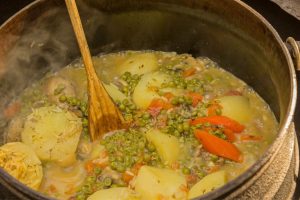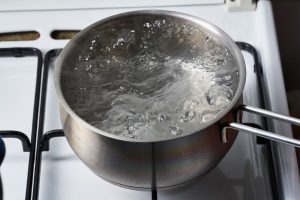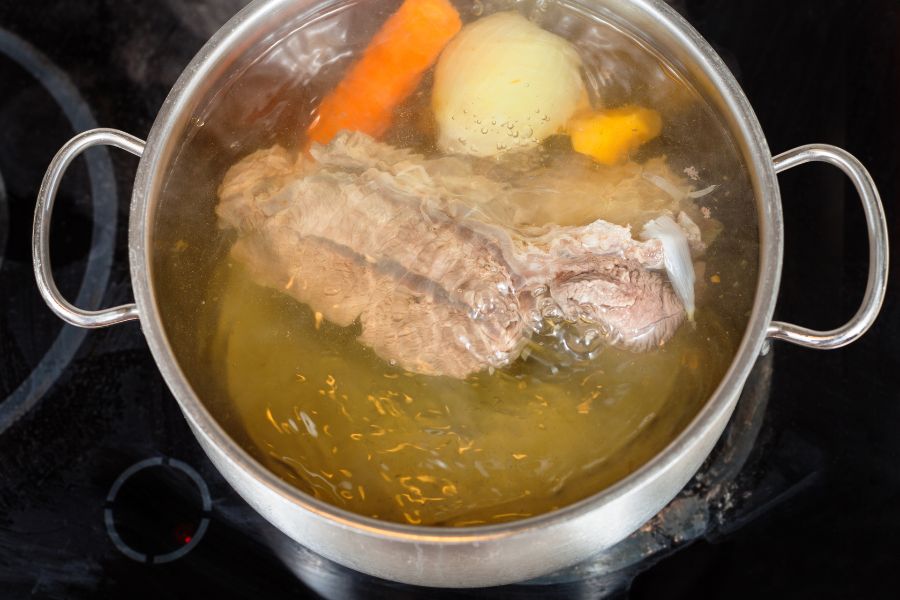Simmering is a fundamental cooking technique that falls between a gentle bubbling and a rolling boil. Understanding what does simmering water looks like is crucial for preparing a wide range of dishes and incredibly delicate foods.
Unlike the vigorous activity in boiling water, simmering is a more subdued and controlled cooking method. This technique benefits recipes with slow and gentle heat, such as soups, stews, and sauces. It allows flavors to meld and ingredients to cook thoroughly without the harshness of boiling, which can sometimes break down ingredients too aggressively. Now, let’s discuss what it looks like.
You can check out other guides like the best way to clean solar lights.
What Does Simmering Water Look Like?
The most notable characteristic of simmering water is the presence of small bubbles and tiny bubbles. These bubbles are a key visual indicator, signifying that the water is at the proper temperature for simmering. Simmering is a more restrained activity, unlike a rolling boil, where large bubbles rapidly break the surface.
The bubbles in simmering water are smaller, less vigorous, and appear intermittently. This gentle bubbling makes simmering ideal for cooking delicate foods that might otherwise disintegrate or lose texture under the intense boiling heat. So, you have to observe the behavior of these bubbles to maintain the correct simmering temperature. And that’s the best way to ensure the food is cooked perfectly.
Temperature Range for Simmering
The temperature range for simmering is another critical aspect to consider. Typically, simmering occurs below the boiling point of 212°F (100°C) at sea level. The ideal temperature range for simmering water is between 180°F to 205°F. This range is slightly lower than what you need to boil pasta but higher than what would be used for poaching.
Maintaining the water within this temperature range ensures that the tiny bubbles characteristic of simmering appear consistently. This provides the perfect environment for cooking foods gently. But you must adjust the heat source to keep the water within this range. In the long run, proper temperature control is key to successful simmering.
Identifying a Simmer – Visual Cues
Recognizing a simmer involves identifying key visual cues in the simmering liquid. A steady simmer is indicated by a consistent pattern of small to medium-sized bubbles that gently rise to the surface. Unlike a rolling boil, where the entire surface is agitated, a simmer displays a more controlled and gentle boil.

This can be observed as a slight movement in the liquid, with bubbles forming and rising slowly but not so vigorously that they disturb the entire surface. Frankly, it’s a cooking method that requires close observation. Because the difference between a simmer and a boil can sometimes be subtle, especially when cooking on high heat.
The Difference Between Simmering and Boiling
For the newbies, differentiating between boiling and shimmering could be mission impossible. So, if you need the subtlety that shimmering offers, you should focus on the following differences:
Temperature Difference
Simmering
This involves cooking at a temperature just below the boiling point of water. The temperature range for simmering is typically between 180°F to 205°F. In this range, the heat is sufficient to cook food but not so high as to cause rapid agitation.
Boiling
Boiling occurs at the boiling point of water, which is 212°F (100°C) at sea level. While this temperature makes it a popular purification method, the temp is higher than simmering, resulting in vigorous movement in the liquid.
Visual Cues and Movement in the Liquid
Simmering
The visual cues for a simmer include small to medium-sized bubbles that gently rise to the water’s surface. The surface of the liquid in a simmer shows a gentle movement with a slight ripple, indicating a less intense heat.
Boiling
Boiling is characterized by large, continuous bubbles that rapidly rise to the surface and a high level of agitation in the water. The entire surface is disturbed, and there is a notable rolling motion, hence the term “rolling boil.”

Cooking Applications
Simmering
It’s ideal for dishes that require slow and gentle cooking. Simmering is perfect for cooking delicate foods, stews, soups, and sauces, where the goal is to infuse flavors without the harshness of boiling.
Boiling
Boiling is suitable for quick cooking or cooking items more receptive to vigorous heat, like pasta and grains, or for rapidly cooking vegetables.
Effect on Food
Simmering
This method is more forgiving and less likely to overcook or break down ingredients. It’s great for dishes that benefit from slow, prolonged cooking, allowing flavors to develop fully.
Boiling
Boiling may be too harsh for some foods, causing them to break apart or become mushy. However, it’s effective for sterilizing water and rapidly cooking food.
Practical Tips for Achieving a Simmer
You can achieve and maintain a simmer with these practical tips:
Adjusting Heat
Start by bringing the liquid to a boil on high heat, then reduce to medium or medium-high heat to achieve a gentle boil. Lowering the heat just enough to reduce the boiling to a simmer is key.
Cooking Different Foods
For delicate items like blanching vegetables, a gentle simmer is ideal. However, maintaining a steady simmer ensures that the root vegetables and meat cook thoroughly without falling apart for heartier dishes like beef stew.
Use of Simmer in Different Dishes
A simmer is not just for soups and stews. It’s also great for dishes like stir fry, where you might want to simmer a sauce to thicken it, or to cook pasta, where a full boil isn’t always necessary.
Common Uses of Simmering in Cooking
Simmering is a versatile cooking method used in various culinary applications:
Cooking Soups and Stews
Beef stew, for example, benefits greatly from simmering. The steady simmer allows the flavors to meld and the meat to become tender without overcooking.
Preparing Vegetables
Simmering is ideal for root vegetables, which require gentle cooking to become tender. It’s also perfect for blanching vegetables, where a brief simmer can soften them slightly while retaining their color and nutrients.
Sauces and Broths
Many sauces and broths require a simmer to reduce and concentrate flavors. A simmering liquid allows the ingredients to infuse into the liquid, enhancing the overall taste and texture.
In each scenario, the simmering technique makes the food cook gently and evenly. Moreover, it preserves flavors and textures that might otherwise be lost with more aggressive cooking methods like boiling.
Summary
Simmering is a fundamental cooking technique that perfectly balances the aggressive heat of boiling and the gentleness of poaching. It’s a steady simmer of small to medium-sized bubbles and a controlled, gentle boil.
This method is crucial for cooking various dishes, from tenderizing root vegetables in a beef stew to gently cooking delicate sauces. So, cooks can enhance flavors, preserve textures, and achieve desired results in various recipes by mastering the art of simmering.

